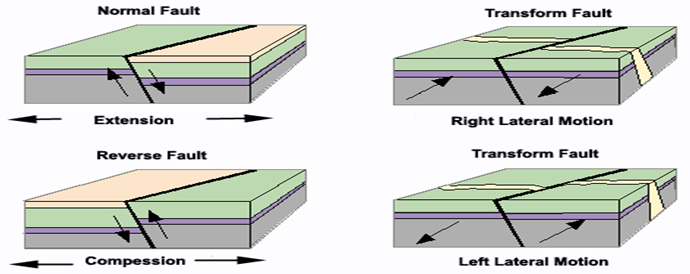Basics of Plate Tectonics and Seafloor Spreading
Lithosphere is made up of about a dozen giant and several smaller sections called plates, and these move in various directions in processes known collectively as plate tectonics. The below graphics shows the plates and their general direction of Movement.

Earthquakes, volcanoes, and other geologic events are concentrated where plates separate, collide, or slide past one another. Where they separate, rifting produces very low land elevations (e.g. well below sea level at the Dead Sea of Israel and Jordan) or the emergence of new crust on the ocean floor (e.g. in the middle of the Atlantic Ocean).
The central item in the Plate Tectonics is the Mid-Oceanic Ridge. The mid-ocean ridges of the world are connected and form a single global mid-oceanic ridge system that is part of every ocean, making the mid-oceanic ridge system the longest mountain range in the world. The continuous mountain range is 65,000 km (40,400 mi) long and the total length of the oceanic ridge system is 80,000 km (49,700 mi) long.

When the ocean floors such as Mid-Atlantic Ridge and the East Pacific Rise, new lithosphere is “born” as molten material rises from the earth’s mantle and cools into solid rock. Plate tectonics are often explained by the useful analogy of a “conveyor belt” in constant motion. On either side of the long, roughly continuous ridges, the two young plates move away from one another, carrying islands with them; this process is called seafloor spreading.
Seafloor spreading has few impacts on us, but when the earth’s plates collide, there is cause for great concern: tectonic forces are among the planet’s greatest natural hazards. The seismic activity (seismic refers to earth vibrations, mainly earthquakes) that causes earthquakes and tsunamis (tidal waves) and the volcanism (movement of molten earth material) of volcanoes and related features are the most dangerous tectonic forces.
Subduction
We have already studied that the Oceanic lithosphere is thinner and denser, whereas continental lithosphere is thicker and lighter. Both of these crustal plates float on the plastic asthenosphere. We can visualize this as two blocks of wood floating in water, where a thicker block rides higher above the water surface than a thinner block. This implies that the thicker continental surfaces rise higher above the ocean floors.
In the below graphics, there are four plates viz. A, B, C and D. Plate A and B are pulling apart along their common boundary, which lies along the axis of a midoceanic ridge. When they pull apart, it creates a gap in the crust that is filled by magma rising from the mantle beneath. At greater depth under the rift, magma solidifies into plutonic rocks. The boundary between the plates A and B is called a spreading boundary.

In the right, we see that the oceanic lithosphere of plate B is moving toward the continental lithosphere of plate C. Where these two plates collide, they form a converging boundary. Here, since the oceanic plate is comparatively thin and dense, in contrast to the thick, buoyant continental plate, the oceanic lithosphere bends down and plunges into the asthenosphere. The process in which one plate is carried beneath another is called subduction. The descending lithosphere is melted again as it dives into the earth’s mantle along a deep linear feature called trench (such as the Mariana Trench off Japan). Subduction is another stage along the “conveyor belt” process that will eventually see this material recycled as newborn lithospheric crust. This subduction process releases enormous amounts of energy. The great stress of one plate pushing beneath another is released in the form of an earthquake. The world’s largest recorded earthquakes—registering 9.5 (Chile, 1960), 9.2 (United States, 1964), and 9.1 (Indonesia, 2004), respectively, on the Richter scale, which measures the strength of the earthquake at its source—struck along these subduction zones. This sudden displacement of a section of oceanic lithosphere is also what triggers a tsunami and the attendant loss of life and property such a powerful wave can cause. Further, the Volcanism generally occurs at places near the subduction zones.
Movement of Plates – Faulting
In some other places, the lithospheric plates grind and slide along one another. The processes of rock crowding together or pulling apart along these fracture lines is known as faulting. The movement along various kinds of faults causes earthquakes, the emergence of new landforms, and other consequences. They are of the following types:
- Normal – tension in the crust (a ‘pulling apart”)
- Reverse – Compression in crust (a ‘pushing in’)
- Reverse Thrust Fault
- Transform

Subduction is responsible for high rates of volcanism, earthquakes, and mountain building. When the large pieces of material on the subducting plate are pressed into the overriding plate, it results in the Orogeny or Mountain formation. These areas are subject to many earthquakes.
Faulting Versus Folding
Please note that both faulting of the Rocks and folding of the Rocks play role in creation of the Earthquake, however, the role of later is also dependent upon the former. Earthquakes usually occur where Earth’s crust has cracks and is weak. The cracks through which these vibrations pass are called Faults. The movement of rocks along these faults cause earthquakes. As a result of the earthquake, the rocks on the surface of earth change from their earlier position. Their up and down bending into elevations and hollows is called folding of rocks. When the folding continues for a long time, the beds of the rocks can no longer bear the pressure of the force. They break and the rocks may be thrown up on one side and down on the other, thus resulting in Faulting.

